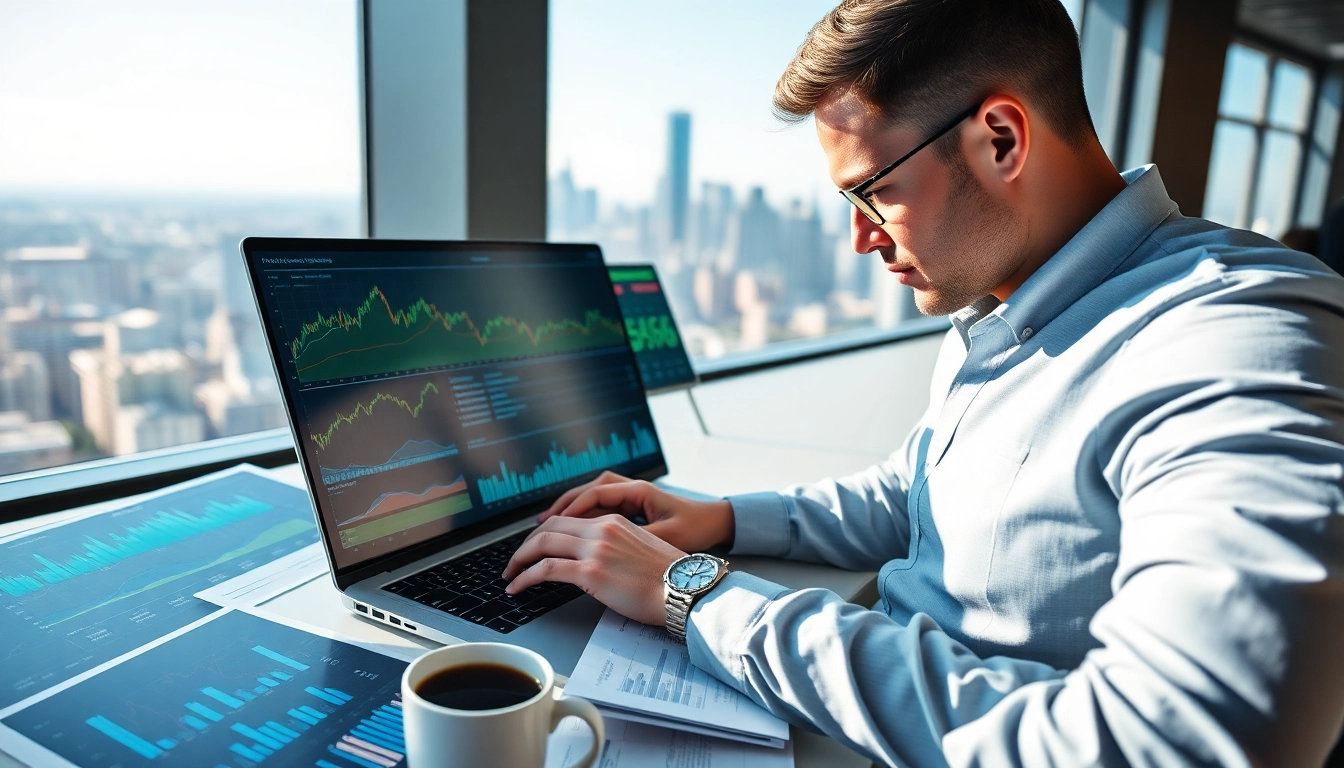What Are Trade Futures?
Definition and Basics of Trade Futures
Trade futures are financial derivatives that obligate the buyer to purchase, or the seller to sell, an underlying asset at a predetermined price at a specified time in the future. This agreement allows traders to speculate on the future price of commodities, currencies, stock indices, and interest rates. Futures are standardized contracts traded on exchanges, and they can serve both hedging and speculation purposes.
Understanding how to trade futures involves recognizing the essential mechanics and market environment where these contracts operate. The standardization of contracts facilitates liquidity and ensures that contracts can be easily bought and sold on regulated exchanges.
Key Components of Trade Futures Contracts
Futures contracts consist of several key components that define their functionality:
- Underlying Asset: This could be a commodity (like oil or corn), a financial instrument (such as treasury bonds), or an index (like the S&P 500).
- Contract Size: This specifies the quantity of the underlying asset covered by the contract (e.g., one crude oil futures contract typically represents 1,000 barrels of oil).
- Contract Expiration Date: Futures contracts have a defined expiration date, after which the contract must be settled either by physical delivery of the asset or by cash settlement.
- Price: The agreed upon price at which the contract will be executed at expiration or upon closing the position.
- Margin Requirements: Traders must deposit a margin that acts as a good-faith deposit to enter a futures contract. Margin ensures that both parties have the financial capability to fulfill the contract obligations.
Common Misconceptions About Trade Futures
Futures trading often comes with a range of misconceptions. Here are a few common ones:
- Futures Are Only for Professionals: While many institutional investors participate in futures markets, individual investors can access futures trading, especially with modern platforms that provide easy entry points.
- High Risk Equals Guaranteed Losses: While futures trading does involve risk, a well-structured trading plan, effective risk management strategies, and education can mitigate these risks significantly.
- You Have to Purchase the Physical Asset: Most futures trading is speculative, meaning traders often close their positions before the expiration date, avoiding the actual delivery of the underlying asset.
Benefits of Trading Futures
Leverage and Capital Efficiency
One of the primary attractions of trading futures is the leverage they offer. Traders can control a large position with a relatively small amount of capital. This means that the economic exposure can be significant without requiring substantial initial investment. For example, if a trader needs to put down 10% of the contract’s value as margin, they have access to the remaining 90% for potential profits. However, it’s crucial to remember that while leverage can amplify profits, it can also magnify losses.
Diverse Trading Opportunities
Futures markets are incredibly diverse, offering trading opportunities across various asset classes, including:
- Commodities: Such as agricultural products (corn, wheat), metals (gold, silver), and energy (crude oil, natural gas).
- Financial Futures: Including options on stock indices, interest rates, and currency futures.
- Cryptocurrency Futures: Adding a modern twist, traders can also invest in futures contracts based on cryptocurrencies such as Bitcoin and Ethereum.
This diverse array allows traders to fine-tune their investment strategies based on market conditions and personal risk tolerance.
Flexible Trading Hours and Accessibility
The futures market operates nearly 24 hours a day, providing traders the flexibility to enter and exit positions at their convenience. This accessibility is particularly advantageous for those who may not be able to trade during traditional market hours. Furthermore, advancements in technology have enabled online trading platforms to offer user-friendly interfaces for trading futures, making it accessible for newbies and seasoned traders alike.
How to Get Started with Trade Futures
Choosing the Right Futures Broker
When venturing into futures trading, selecting a reputable and suitable broker is crucial. Factors to consider include:
- Regulation: Ensure the broker is regulated by a trusted authority like the Commodity Futures Trading Commission (CFTC) in the U.S.
- Fees and Commissions: Review the fee structures, including commissions, spreads, and any additional service charges.
- Trading Platform: The broker’s platform should offer advanced features like charting tools, analysis software, and easy order placement.
- Customer Support: Reliable customer service can make a difference, especially in volatile trading environments.
Creating a Trading Plan and Strategy
A well-structured trading plan is a blueprint for success in futures trading. It should detail your:
- Market Analysis: Include both technical and fundamental analysis to inform your trading decisions.
- Risk Management: Determine how much capital you are willing to risk on each trade and establish rules for setting stop-loss and take-profit orders.
- Goals and Objectives: Define what you wish to achieve with your trading activities over a specific period.
Setting Up Your Trading Account
After selecting a broker and planning your strategy, the next step is setting up your trading account. This process typically involves:
- Account Verification: Providing necessary identification and financial information is required for compliance with regulatory standards.
- Initial Deposit: Fund your account with the minimum required margin to start trading.
- Familiarizing with the Trading Platform: Spend time exploring the platform features and practice using demo accounts to build confidence.
Risks and Challenges of Trade Futures
Market Volatility and Risk Management
Futures trading involves considerable exposure to market volatility, which can lead to rapid changes in account equity. Effective risk management techniques, including diversification, positional sizing, and employing stop-loss orders, are imperative to navigate these challenges successfully. Additionally, traders should stay informed about economic reports and events that may impact market conditions.
Legal and Regulatory Considerations
The futures market is heavily regulated to ensure fair trading practices and protect investors. As a trader, you must understand the rules set forth by regulatory bodies like the CFTC. Compliance with regulations not only safeguards your interests but also enhances the integrity of the markets.
Trading Psychology and Emotional Discipline
Trading psychology is a critical yet often overlooked aspect of futures trading. Emotional responses to trading outcomes can derail even the best strategies. Traders must cultivate discipline to stick to their trading plans and avoid impulsive decisions based on fear or greed. Techniques such as keeping a trading journal to reflect on decisions can help in developing emotional resilience.
Advanced Techniques in Futures Trading
Using Technical Analysis in Trade Futures
Technical analysis employs historical price data to forecast future price movements. Traders often use tools such as charts, indicators, and patterns to make informed trading decisions. Commonly used indicators in futures trading include:
- Moving Averages: Help identify trends by smoothing price data.
- Relative Strength Index (RSI): Indicates whether an asset is overbought or oversold.
- Bollinger Bands: Assist in determining volatility and price levels.
In combination with other analytical methods, technical trading can add a significant edge to your trading strategy.
Implementing Algorithmic Trading Strategies
Algorithmic trading involves using computer algorithms to automate trading strategies based on predefined rules. This approach allows for quicker execution of trades, reduced emotional decision-making, and the ability to process large amounts of data to identify trading opportunities. However, developing a successful algorithm requires a robust understanding of market structures, risk management, and continuous refinement based on performance metrics.
Evaluating Performance Metrics and Adjustments
As a trader, monitoring your performance is crucial to long-term success. Key performance metrics include:
- Win Rate: The percentage of profitable trades relative to total trades.
- Risk-Reward Ratio: The average profit earned on winning trades versus the average loss sustained on losing trades.
- Maximum Drawdown: The largest decline in account equity observed over a specific period. Minimized drawdown indicates effective risk management.
Analyzing these metrics can help traders refine their strategies by identifying strengths and weaknesses, ultimately improving performance.



